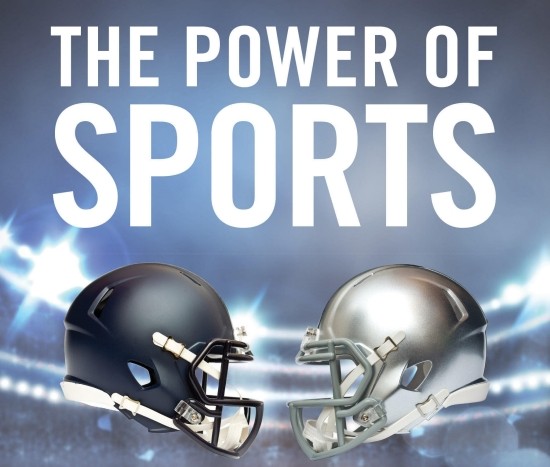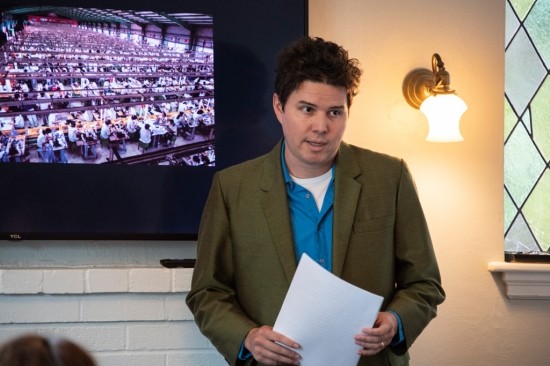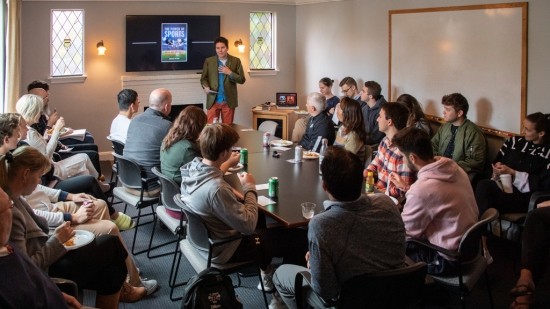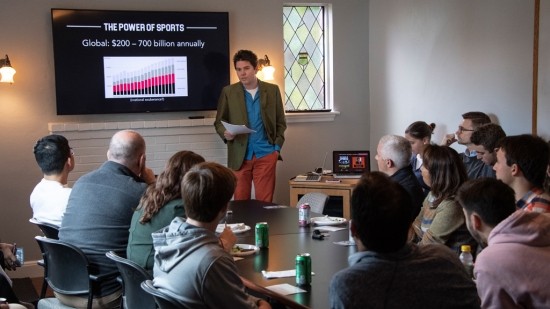The Power of Sports: Media and Spectacle in American Culture

Michael Serazio
Boston College
Date: Friday, October 4, 2019
Time: 12–1:15 p.m.
Location: Boisi Center, 24 Quincy Road
Abstract
Drawing upon dozens of interviews with media professionals and business leaders, "The Power of Sports" goes behind-the-scenes to explore how today's ubiquitous, $70 billion sports spectacle is crafted. In an era of deep fragmentation, the book provocatively analyzes how sports culture explains and reflects life across a wide range of patterns in American culture: religious experience, technological disruption, journalistic sensationalism, economic inequality, military hawkishness, and masculine ideals. Far from being about "just a game," "The Power of Sports" holds up a mirror to the sports industry and reveals the lived realities of the nation staring back at us.
Speaker Bio

Michael Serazio is an associate professor of communication at Boston College who studies media production. A former journalist, his writing has appeared in the Journal of Communication and Critical Studies in Media Communication as well as The Washington Post and The Atlantic.

Michael Serazio of Boston College gave a presentation on the power of sports to a full audience at the Boisi Center.


Photos by MTS photography
Event Recap
In the first luncheon colloquium of the academic year, Michael Serazio explored “The Power of Sports” in contemporary American society. Far more than a form of entertainment, Serazio argued that sports are a way in which American society derives its meaning, contending that sports have filled the gap left by the decline of organized religion. He then analyzed this meaning through sports’ relationship to journalism, commercialism, gender, and politics.
Sports can be understood as a great unifier, Serazio argued. At a time when entertainment is individualized and on-demand, sports are more pervasive and air non-stop. Sports journalism, he added, manufactures the meanings and illusions that accompany the sports. The rise of social media, however, has forced those same journalists to sacrifice their journalistic integrity to compete for viewers against the same players or teams that they cover. Why go to ESPN to read about Lebron James when you can simply go to his Instagram profile? Stories are necessary, and journalism creates them.
Serazio then explored sports’ second, though closely related, relationship to commercialism. Since information is instantaneous, consumers’ attention spans shorter, and marketing dollars subject to competition, sports journalists are pushed towards the “hot take”: to write the most outrageous or controversial opinion to ensure views, likes, clicks, and retweets from fans. This leads to over- worked and underpaid journalists and, most importantly, contributes to a shift in journalism—no longer is there a concern for objectivity, journalists validate popular opinions.
Serazio then turned to the relationship between sports and gender. For men, sports embody and express the epitome of masculinity. For example, Serazio described how male athletes are encouraged to “play through the pain.” Of all sports writers, anchors, and commentators, over 90% are men. Women in these fields often face sexism and discrimination and are held to a double-standard. For example, women are expected to be pretty and smart yet a single error is enough to destroy their career.
Lastly, Serazio turned to sports as the expression of our politics. Since Colin Kaepernick’s protest against the treatment of black Americans by kneeling during the national anthem, many have called for a strict separation between sports and politics. Serazio argued that such a separation is impossible as sports are bound up with the expression of two central political issues facing society: economics and the military. The central myth of sports culture—that the key to achievement is merely hard work—is a major tenet of the meritocracy work ethic. This messaging justifies America’s capitalist regime and asserts, at least implicitly, that poverty is the product of laziness. Additionally, sports have been used since ancient times as a way to prepare for war or celebrate military excellence. That is still true today, Serazio explained. Consider the way war veterans are brought out onto the football field where their sacrifice for our country is acknowledged for a few minutes before a football game starts. To some, “this is the least we can do.” For Serazio, it affirms on-going American military intervention on the world stage and occludes any critical reflection on that intervention.
Serazio concluded by affirming that, as these relationships illustrate, sports define us, create our collective consciousness, and are a reflection of who we are as Americans. The Q&A that followed focused on the sports culture at Boston College, new legislation that allows college athletes to receive compensation for their contribution to college athletics, the rising costs of sport events and what that means for local economies, as well as potential remedies to sports’ runaway domination in American culture.
Read More
BOOKS
Haridakis, Paul M. and Adam C. Earnheardt. Sports Mania: Essays on Fandom and the Media in the 21st Century. Jefferson, N.C.: McFarland, 2014.
Higgs, Robert J. God in the Stadium: Sports and Religion in America. Lexington, K.Y.: University Press of Kentucky, 2015.
Jarvie, Grant. Sport, Culture, and Society. New York: Routledge, 2012.
Serazio, Michael. The Power of Sports: Media and Spectacle in American Culture. New York: NYU Press, 2019.
ARTICLES
MacArthur, Heather J. and Stephanie A. Shields. “There’s No Crying in Baseball, or Is There? Male Athletes, Tears, and Masculinity in North America”. Emotion Review 7, no. 1 (Winter 2014): 39-46. https://bit.ly/2nb2cud
Serazio, Michael. “The Elementary Forms of Sports Fandom: A Durkheimian Exploration of Team Myths, Kinship, and Totemic Rituals”. Communication and Sport 1, no. 4 (Fall 2012): 303-325. https://doi.org/10.1177/2167479512462017.
Serazio, Michael. “When the Sportswriters Go Marching In: Sports Journalism, Collective Trauma, and Memory Metaphors.” Critical Studies in Media Communication 27, no. 2 (Spring 2010): 155–73. https://doi.org/10.1080/15295030903551009.
Thorson, Emily A. and Michael Serazio. “Sports Fandom and Political Attitudes.” Public Opinion Quarterly 82, no. 2 (Summer 2018): 391–403. https://doi.org/10.1093/poq/nfy018.
In the News
In a recent New York Times article, Greg Easterbrook asserts that football, and all its traditions, are here to stay. He writes that football’s future is brighter than ever regardless of the recent evidence of brain trauma from concussions. Easterbrook points out that brain trauma rates are falling due to increased safety measures, such as no-contact practices, at the high school, college, and professional football levels. On Friday, October 4th, the Boisi Center will host Michael Serazio for a Lunch Colloquium, where he will present on how sports reflect and interpret American culture, religion, and politics.

